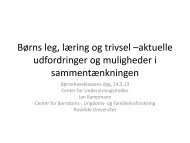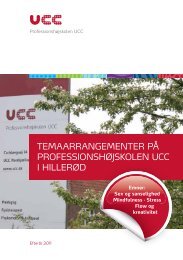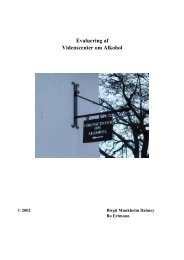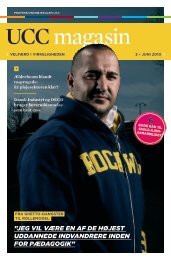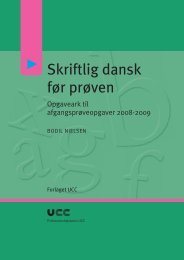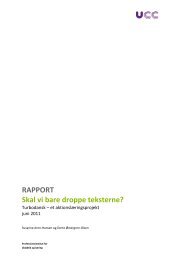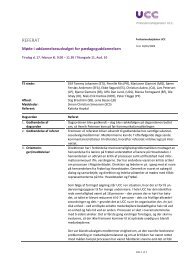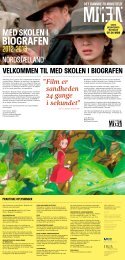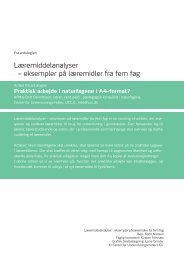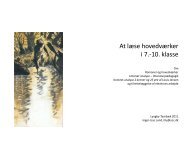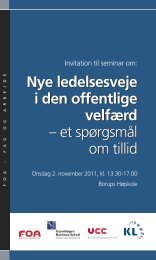AGORA - tidsskrift for forskning, udvikling og idéudveksling i ...
AGORA - tidsskrift for forskning, udvikling og idéudveksling i ...
AGORA - tidsskrift for forskning, udvikling og idéudveksling i ...
You also want an ePaper? Increase the reach of your titles
YUMPU automatically turns print PDFs into web optimized ePapers that Google loves.
<strong>AGORA</strong> - <strong>tidsskrift</strong> <strong>for</strong> <strong>for</strong>skning,<br />
<strong>udvikling</strong> <strong>og</strong> <strong>idéudveksling</strong> i professioner<br />
shape our own narratives or where the involvement in specific settings or communities of practice pushes<br />
ahead changes in our individual stories about situations or our life in a broad perspective. In communities<br />
of practice, narratives of the community go beyond the individual stories. Rules, norms, habits, rituals and<br />
ways of doing evolve from the situated learning process, and narratives are <strong>for</strong>med relating to the acting<br />
and cooperating in the community.<br />
As a conclusion, I would like to put emphasis on the interrelation of all the dimensions described:<br />
Experiencing, meaning-making, embodied and situated action, co-creation of meaning in a community<br />
of practice, and the <strong>for</strong>ming and re-<strong>for</strong>ming of narratives as part of our being a social creature are all<br />
processes that are interwoven. In some situations, the experience is dominant on the personal level, in<br />
others, the cooperation and situated action in a community of practise. But usually things cannot be held<br />
apart and distinguished in real life situations.<br />
Body-anchored and experience-based learning – how does it work?<br />
Any learning process can be stimulated or supported, both by personal strategies and through the help<br />
and guidance of a second person, a teacher, coach, friend or therapist. Attention to and awareness of our<br />
body is a possibility we have, but we often do not make use of it. Many people are not very conscious<br />
of their body and its resources in regard to learning and developing, both in professional and personal<br />
matters. But the first-person approach and different strategies which mobilize bodily resources can help<br />
us to develop ourselves. On the basis of the premises and reflections presented in the previous sections,<br />
a number of principles, strategies and techniques will be presented in the following as dimensions <strong>for</strong> a<br />
methodol<strong>og</strong>y of body-anchored and experience-based learning. This will be done by presenting a set of<br />
general guidelines and by concretising some selected techniques in relation to specific learning situations,<br />
several of them directly related to sports and games – which is my scope of work, some of them with a<br />
more general approach to body and experience.<br />
Focusing<br />
Focusing is a method developed in and <strong>for</strong> psychotherapy, and intended to unlock the wisdom of ones<br />
body (Gendlin, 1981). Focusing is an approach where the attention is on the immediate, sensuous<br />
experience of the present moment and on embodied awareness as the key to pre-reflective or implicit<br />
knowledge which is embedded in our consciousness. The focusing process takes its starting point from<br />
what Gendlin (1981; 1996; 1997) calls the felt sense or felt meaning. Gendlin (1981) defines the felt sense<br />
as follows:<br />
“The felt sense is not a mental experience but a physical one. Physical. A bodily awareness<br />
of a situation or person or event. An internal aura that encompasses everything you feel and<br />
know about the given subject at a given time – encompasses it and communicates it to you<br />
all at once rather than detail by detail. Think of it as a taste, if you like, or a great musical<br />
chord that makes you feel a powerful impact, a big round unclear feeling.” (p. 32; italic in<br />
the original)<br />
Cox and Theilgaard (1987) support Gendlin’s ambition of gaining access to the pre-reflective by<br />
describing the position of the second person, e.g., of the coach or therapist, as standing on the<br />
“perceptive ‘tip-toe’, trying to detect what is on the brink of being called into existence <strong>for</strong> the first time”<br />
(p. 23).<br />
The felt sense of a specific event is not an unchanging phenomenon. Working with the felt sense can be<br />
described as a spiral process: A specific felt sense becomes explicit and finally expressed in words. This<br />
imagery and the verbal representation of this specific felt sense often lead to a change in the felt sense.<br />
Gendlin calls this operation “resonating”. It is a going back and <strong>for</strong>th between the felt sense and the word,<br />
phrase or image which grows out of this resonating. Gendlin (1981) gives the following advice: “Let the<br />
www.cvustork.dk/agora/ 15





